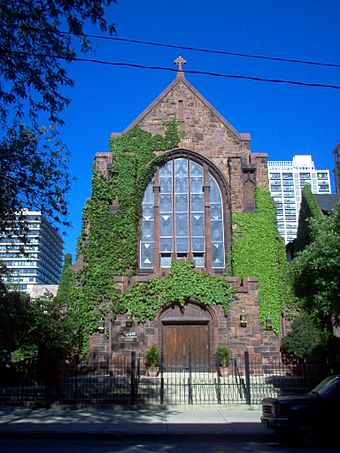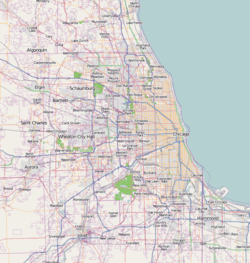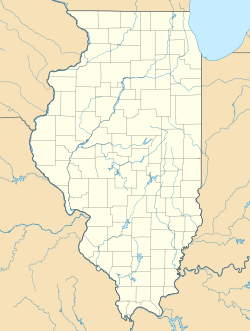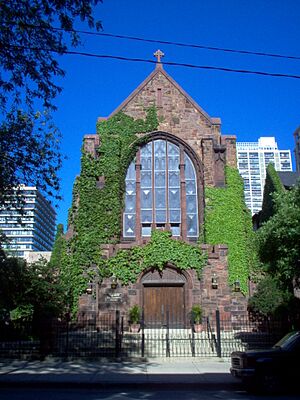Episcopal Church of the Atonement and Parish House facts for kids
Quick facts for kids |
|
|
Episcopal Church of the Atonement and Parish House, The
|
|
 |
|
| Location | 5751 N. Kenmore Ave., Chicago, Illinois |
|---|---|
| Area | less than one acre |
| Built | 1889 |
| Architect | Henry Ives Cobb |
| Architectural style | Gothic Revival |
| NRHP reference No. | 09000590 |
| Added to NRHP | July 30, 2009 |
The Episcopal Church of the Atonement and Parish House is a very old church building in Chicago, Illinois. It is located at 5751 North Kenmore Avenue. This beautiful building was built in 1889. It has a special style called Gothic Revival. Because of its history, it was added to the National Register of Historic Places in 2009.
Contents
Church History in Chicago
In 1886, several families who were part of the Episcopal Church met in a building in the Edgewater neighborhood of Chicago. They decided they wanted to build their own church. By 1888, a lawyer named Frederick W. Keator started holding church services for them. In November 1888, this group officially became a mission church. They chose the name "Church of the Atonement."
The first stone for the church was placed on November 30, 1889. The church was officially opened in June 1890. By then, Mr. Keator had become a minister. He was the first priest to lead the new church. He stayed until 1896. Later, he became the first Bishop of the Olympia diocese in Washington state.
Growing the Church Community
In May 1898, the church became a self-supporting parish. This meant it could pay for itself. It had 120 members. Around this time, they started building the Parish House next to the church. The Parish House was finished in 1901.
In the early 1900s, the church became very important. It was one of the main Anglo-Catholic churches in the country. From 1910, the church building was made much bigger. This happened under the leadership of Rector Charles E. Deuel. The church had more than 500 members by then.
Building Expansions
The church was expanded twice, in 1910 and 1919. A British church member named J.E.O. Pridmore helped with these projects. He made sure the church kept its English Gothic style. The first service in the newly expanded church was on Easter in 1920. By then, the church had 650 members.
In 1922, a new Parish House was started and finished in 1924. Beautiful stained glass windows were added to the church starting in 1929. The last window was put in place in 1946.
Community Outreach and Music
Under Rector Dean Paxton Rice, the church received a special gift: an old Elizabethan-era room with wood panels. This room was installed in the Parish House. The church also worked to help its neighbors. It started a mission for the Native American community in the nearby Uptown neighborhood. In the 1970s, the church began a ministry for Spanish-speaking neighbors.
The church also became known for its excellent music program. It had a choir that grew to include women. A special organ was also built for the church.
Church Building Design
A church member named Henry Ives Cobb designed the first church building. He included a stone tower on one corner. He also designed the east wall out of wood so it could be easily expanded later. Henry Ives Cobb was famous for his English Gothic and Romanesque style buildings. He designed other important buildings in Chicago, like the Newberry Library.
Current Church Structure
Mr. Pridmore's expansion, finished during World War I, created the church as it looks today. The roof was made taller and extended. Side aisles were also added. Stained glass windows were put in, with the last one added after World War II.
The "Christ the King" window in the North Chapel is a great example of the stained glass. It is considered one of the best stained glass windows in Chicago.
The Elizabethan Room
On the second floor of the Parish House, there is a special room called the Elizabethan Room. This room's wood paneling came from England in 1620. It is registered with The Art Institute of Chicago. It is the only real example of its kind in the Midwest.
Church Leaders (Rectors)
Here are some of the people who have led the church:
- Frederic William Keator: 1888-1896
- J. M. D. Davidson: 1896-1903
- Charles E. Deuel: 1903-1914
- Frederic Sydney Fleming: 1915-1927
- Alfred Newbery: 1927-1937
- Calvert Buck: 1937-1943
- James Murchison Duncan: 1943-1950
- Robert Leonard Miller: 1950-1958
- Dean Paxton Rice: 1958-2003
- John David van Dooren: 2005-2017
- Erika Lee Takacs: 2018-2022
Current Status
The Reverend Charles Everson became the new Rector in October 2023.





